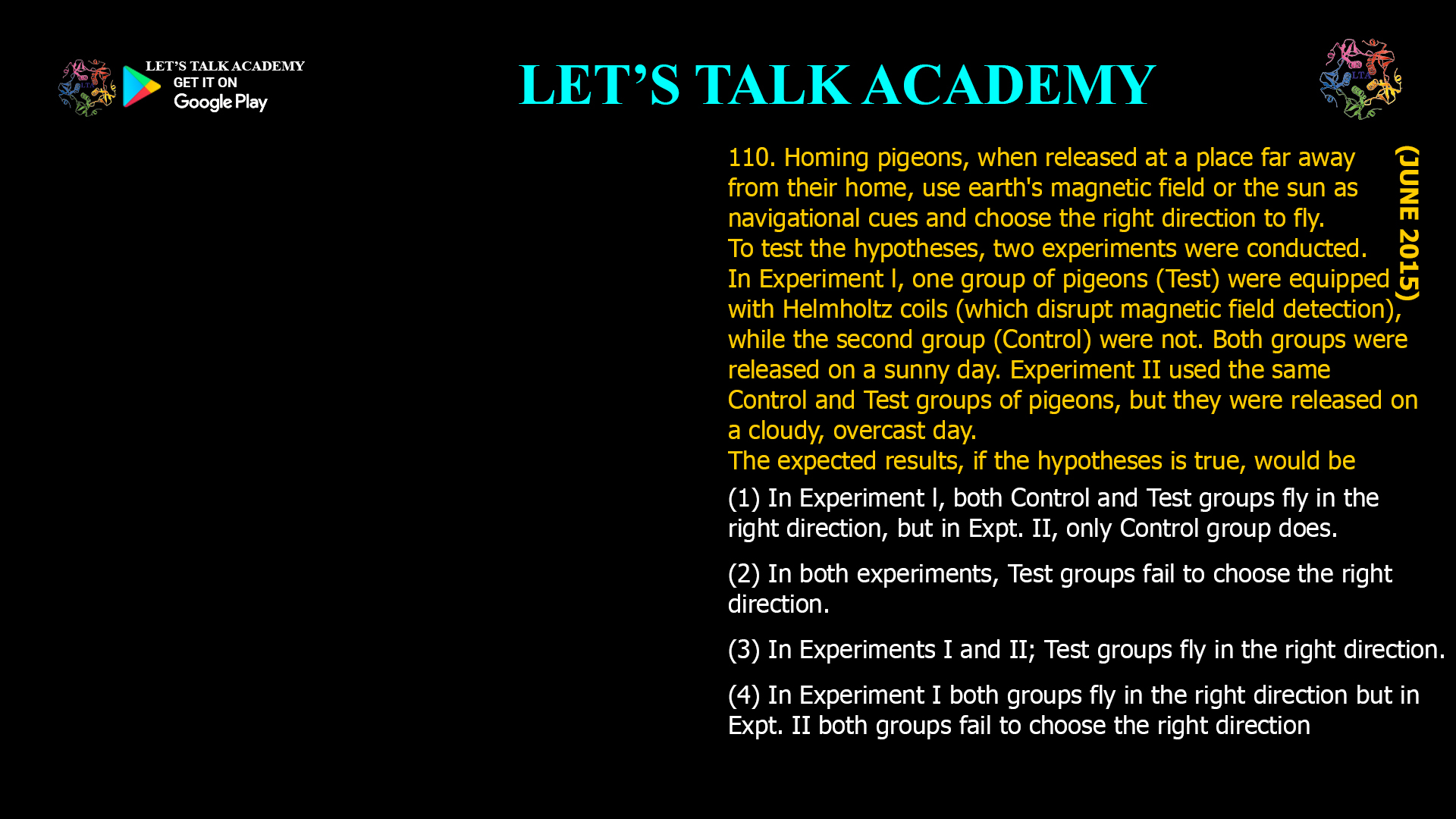- Homing pigeons, when released at a place far away from their home, use earth’s magnetic field or the sun as navigational cues and choose the right direction to fly. To test the hypotheses, two experiments were conducted. In Experiment l, one group of pigeons (Test) were equipped with Helmholtz coils (which disrupt magnetic field detection), while the second group (Control) were not. Both groups were released on a sunny day. Experiment II used the same Control and Test groups of pigeons, but they were released on a cloudy, overcast day.
The expected results, if the hypotheses is true, would be
(1) In Experiment l, both Control and Test groups fly in the right direction, but in Expt. II, only Control group does.
(2) In both experiments, Test groups fail to choose the right direction.
(3) In Experiments I and II; Test groups fly in the right direction.
(4) In Experiment I both groups fly in the right direction but in Expt. II both groups fail to choose the right directionThe Navigation Cues: Sun and Magnetic Field
Pigeons are known to use:
-
The Sun Compass: On sunny days, pigeons use the sun’s position, along with their internal biological clock, to determine direction.
-
The Magnetic Compass: On cloudy or overcast days, when the sun is not visible, pigeons rely on the Earth’s magnetic field to navigate.
The Experiments
Experiment I: Sunny Day Release
-
Test Group: Pigeons equipped with Helmholtz coils, which disrupt their ability to detect the Earth’s magnetic field.
-
Control Group: Pigeons without coils, with normal magnetic field detection.
-
Condition: Both groups released on a sunny day.
Experiment II: Overcast Day Release
-
Same Test and Control Groups as above.
-
Condition: Both groups released on a cloudy, overcast day, with the sun obscured.
Expected Results If the Hypothesis Is True
If pigeons use the sun as their primary navigational cue on sunny days, and the magnetic field on overcast days, the following outcomes are expected:
Experiment I (Sunny Day)
-
Control Group: Flies in the correct direction using the sun.
-
Test Group: Also flies in the correct direction, since the sun is available and the disrupted magnetic sense is not needed.
Experiment II (Overcast Day)
-
Control Group: Flies in the correct direction using the Earth’s magnetic field.
-
Test Group: Fails to choose the right direction because their magnetic sense is disrupted and the sun is not available as a backup cue.
Why This Pattern Occurs
-
Redundancy in Navigation: Pigeons have evolved to use multiple cues, switching between them based on environmental conditions.
-
Experimental Disruption: The Helmholtz coils specifically block the magnetic sense, so on days when only the magnetic field is available (overcast), the test group is lost.
Correct Answer
(1) In Experiment I, both Control and Test groups fly in the right direction, but in Expt. II, only Control group does.
This result supports the hypothesis that pigeons use the sun when available, but switch to magnetic cues when the sun is obscured. Disrupting the magnetic sense only impairs navigation when the sun cannot be used.
Conclusion
Homing pigeons are remarkable navigators, relying on both the sun and Earth’s magnetic field. Carefully designed experiments show that when one cue is disrupted, pigeons can compensate—unless both cues are unavailable. This research highlights the sophisticated and flexible navigation systems evolved by birds.
-




1 Comment
Kajal
October 12, 2025Option 1